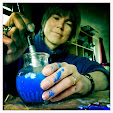
Once I'd re-trained my gaze to look at the smaller animals around me, I realised that I'd been walking right past some beautiful insects - and some fascinating behaviour. In our local woodland I found Peacock Butterflies feeding on Devilsbit Scabious in a patch of sunlight.

When camping on the beach this summer, I noticed Painted Lady Butterflies resting on the lichen-covered rocks and feeding on thrift. I thought that these insects were flying around in circles, until I realised that they were all traveling in the same direction. There was a continual stream of butterflies coming in from the sea and fluttering northwards, on a migration of maybe hundreds of miles.

My daughter found the caterpillar of an Emperor Hawkmoth in a neighbour's garden. It's a bulbous-headed, many-"eyed" caterpillar, the colour of the soil - not very beautiful. It metamorphosed into a chrysalis, which we kept over winter. The moth hatched the following May. Its colours were startlingly beautiful. When we released it onto its food-plant, the honeysuckle, it almost blended in.

In August, Golden-ringed Dragonflies patrol the ditches between heath and oakwood in Taynish Nature Reserve. The closer you look, the more fascinating these insect seem. I'd love to look at them under a really high-powered microscope. If I'm not careful I'll find myself on a one-way Alice-in-Wonderland trip. Dragonflies are such fantastical creatures that sometimes they do seem unreal.

Between children and printmaking, there's not much time for domestic luxuries such as gardening. The weeds are growing up around the patio, and sitting out in the sun with a cup of coffee, I noticed hoverflies feeding on the flowers of a huge Sow Thistle. There seemed to be many different types - big and small, chunky and slight, all with different bar-codes on their bottoms. And for a weed, the Sow Thistle is a beautifully sculptural plant.


